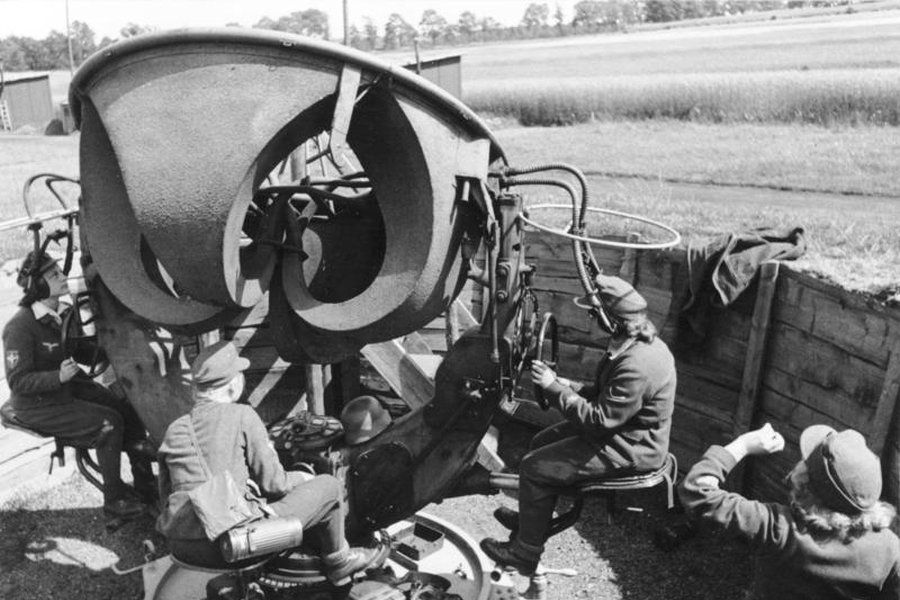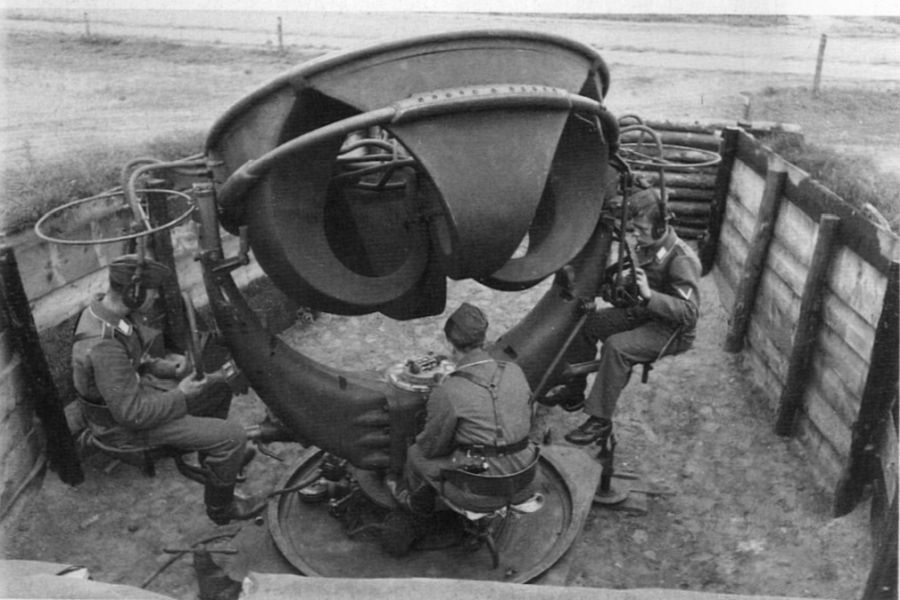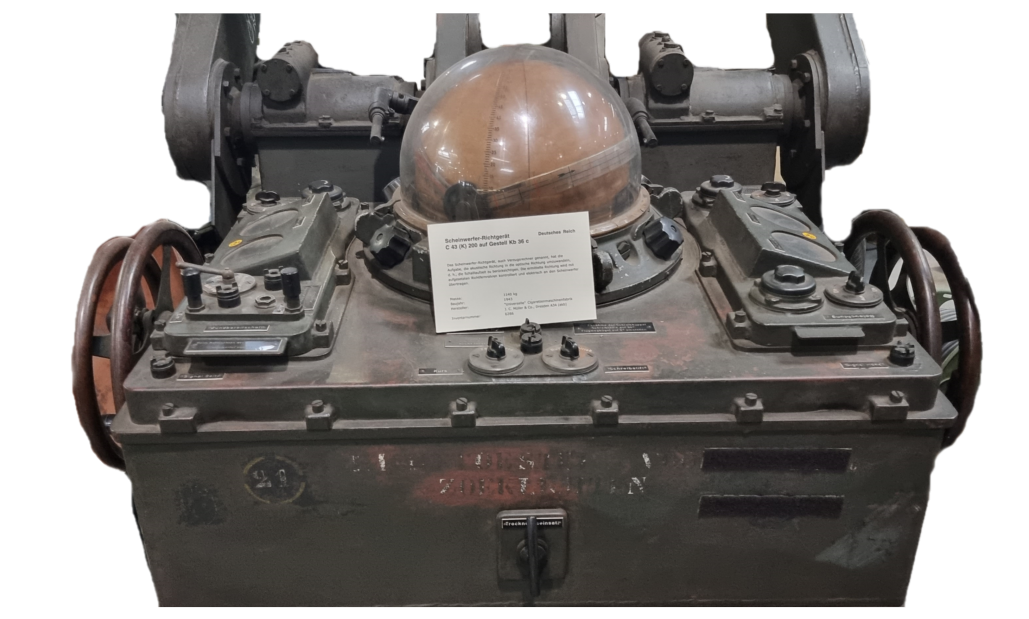
Until the beginning of the Second World War, the anti-aircraft searchlight batteries were each equipped with six to eight RRHs, which the troops called listening devices for short. These were used to acoustically detect approaching enemy aircraft at night and to roughly determine their direction of flight using two sound horns for lateral and elevation values. When both listeners had a "central impression" by swinging the horns, i.e. the engine noise of the aircraft being targeted then reached both ears of each listener without a time difference, they pressed a hand button independently of one another. The delay calculator on the back of the device then calculated the distance that the target had covered on the ground between the sound being emitted and the detection of it, taking into account the target movement and an estimated target speed. The new angular values were transmitted to the searchlights by telephone or electronically. This target guidance made it easier for the searchlights to find and detect the target. The listening range of around 4 to 12 km was, however, very dependent on the weather conditions, the engine noise of the aircraft being targeted, ambient noise, and the listening ability of the listeners. As the flight speeds and altitudes of the targets increased, the listening performance was soon no longer satisfactory. Direct cooperation between the listening device and the heavy anti-aircraft battery, as practiced up until the first year of the war, was abandoned because after the RRH had determined the course values, there was no longer enough time for a command device to calculate the firing values and open fire effectively. The RRHs were therefore mainly used to guide the searchlights. But even when radio measuring devices later performed this task better, the RRHs could not be dispensed with entirely. The missing number of FuMg. was just enough to directly supply the anti-aircraft batteries with the required power. RRHs remained. as redundancy in case of failure of the measuring devices due to interference from the enemy (chaff/Stalinol strips). Source: Marinehelfer in the Kugelbake battery

Such funnel sound listening devices were widely used at the beginning of the war. These devices were also used in Cuxhaven. (See above). Source: Private

The successor was the ring judge listening device, as shown here. Such a model is said to have stood in Stickenbüttel on the Galgenberg in the immediate vicinity of the anti-aircraft searchlight. Source: Federal Archives Image 183-E12007
Listening device C39 with electrical sensors (German Empire)
The funnel sound listening device was used to acoustically locate aircraft targets. One "listener" (operator) for side and one for height points the device towards the sound source. The values determined are sent to the searchlight aiming device (deflection calculator) by shout, telephone or electrical remote transmission. The range is 4 to 15 km with a bearing accuracy of 0.5° to 1.5°. It depends on the weather conditions, the volume of the aircraft to be located, the volume, the background noise and the ability of the operating crew. The funnels are designed as revolution paraboloids with exponential sound conduction.
Base of the side funnels: Base of the height funnels:Dimensions:Year of construction:
Manufacturer:Inventory number:
260 cm 164 cm 400 kg 1940 Manufacturer: Fa. Jurk Sirenenfabrik, Rupert Rauch, Radeberg-Dresden 6285

Source: Military Technology Study Collection Koblenz
(Ringtrichter-Richtungshörer-RRH)
The listening device generally used in World War II was the ring funnel directional listener (RRH). In this device, the four sound funnels were combined to form a funnel ring, which meant that there was no need to precisely align the individual funnels after a change of position. The ring funnel directional listener consisted of the 732 kg bed, the base, the column, two support arms, the ring funnel, the lateral and elevation drives and the permanently installed delay computer. The device could be moved on the two-axle special trailer 104. A listening team consisted of a listening team leader, an operator sat at the delay computer on the back of the device and an operator to the left and right as a listener. Both listeners had to have particularly good hearing, which was trained through ongoing exercises. Since sound travels 333 meters per second in normal weather conditions, a considerable amount of time passes before it reaches the ears of the listeners in front of the source, i.e. the aircraft. During this time, the target travels a certain distance depending on its distance and speed. The values recorded by the "listeners" were immediately passed on to the delay computer installed in the frame. After evaluation, the target data was immediately passed on from there to the anti-aircraft searchlight, which was then aligned accordingly. The calculation in the delay computer was carried out mechanically.

Above: In the photo you can see the operating personnel of an RRH at their positions. The K8 is operating the side funnel on the left. The K9 is sitting on the right at the elevation funnel and in the middle the K7 is sitting at the delay computer. The delay computer on the RRH was permanently connected to the listening device.
Range:Directional accuracy:Operation:Year of manufacture:Manufacturer of the listening device:Manufacturer of the special trailer:
Approx. 12 kilometers /- 2°3 forces1935Elektroakustic AG. KielFa. Lindner, Ammendorf
Source: Military Technology Study Collection Koblenz
Headlight aiming device C 43 (K) 200 on frame Kb 36 c (German Reich)
The headlight aiming device, also known as the delay calculator, had the task of converting the acoustic direction into the optical direction, i.e. taking the sound travel time into account. The determined direction is checked using attached aiming telescopes and transmitted electrically to the headlight.
Dimensions:Year of construction:
Manufacturer:Inventory number:
1140 Kg
1943
"Universelle” Cigarettenmaschinenfabrik J.C.Müller & Co., Dresden A34 (akb)
6285

Source: Military Technology Study Collection Koblenz


